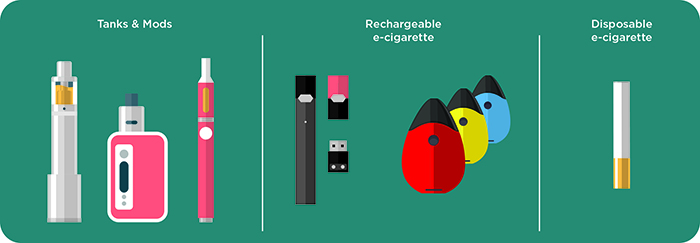Is Vaping Safe? A health strategy or smoke screen?
Author’s Note: As I update this column (which originally ran on March 15, 2018) I’m even more concerned about e-cigarettes than I was a year and a half ago. CBS News reported last week that about 20 percent of U.S. kids are vaping, some as young as 8th grade; A study published by the British Medical Journal (BMJ) shows a 74 percent increase in vaping in Canadian youth. As of September 6, 2019, U.S. health officials are investigating 450 possible cases of severe lung disease associated with vaping across 33 states and one territory, five deaths, and death under investigation — associated with critical lung disease associated with vaping. A lack of regulation or research makes it impossible to know which chemicals or substances are responsible for this sudden increase in lung injury and death. 
According to the World Health Organization (WHO), “Tobacco is the only legal drug that kills many of its users when used exactly as intended by manufacturers.” In the most recent 2017 update, the WHO writes that:
- Tobacco kills up to half of its users
- Tobacco kills more than 7 million people yearly: 6 million from direct tobacco use and approximately 890,000 due to second-hand smoke
- Nearly 80% of the world’s more than 1 billion smokers live in low-and-middle-income countries.

There is no such thing as safe smoking whatsoever, this study concludes. … They found that men who have about one cigarette per day had a 48 percent higher risk of heart disease and 25 percent higher risk of stroke compared to people who have never smoked.
The NCD Alliance reports that tobacco is the leading cause of non-communicable diseases and is the risk factor common to the four main groups of NCDs – cancer, heart disease, chronic lung disease, and diabetes.
Smoking tobacco also increases the risk of death from communicable diseases such as influenza and tuberculosis because it increases susceptibility to bacterial infection — a particular problem in underdeveloped countries where smoking rates are rapidly increasing.
So, are e-cigarettes a safer option? Or as WebMD.com ponders, are they a high-tech way to hook a new generation on a bad nicotine habit?
Are e-cigarettes a better option?
What’s the difference between e-cigarettes and “vaping”? Both are nicotine delivery systems — without combustible tobacco.
 The e-cigarette looks like a traditional cigarette and usually come with pre-filled cartridges. Vaporizers are larger, with a big battery on one end, with a tank to refill e-liquid. I’ll use e-cigarettes here to refer to both.
The e-cigarette looks like a traditional cigarette and usually come with pre-filled cartridges. Vaporizers are larger, with a big battery on one end, with a tank to refill e-liquid. I’ll use e-cigarettes here to refer to both.
They work similarly: they have containers filled with liquid, typically made of nicotine, flavorings, and other chemicals. A heating device turns the liquid into a vapor that you inhale when you take a drag. Although most use nicotine derived from tobacco, some companies use synthetic nicotine — the same molecular structure as the plant-derived drug — and just as addictive.
As reported in ScienceNews.org, e-cigarettes generate toxic chemicals similar to tobacco. Even though the vapor that’s inhaled doesn’t contain combustion products or tar released by tobacco burning, “vaping” causes lung inflammation and protein damage, and lowered immunity.
According to Cancer.net, the e-cigarette ‘juice’ contains a toxic chemical found in antifreeze and several cancer-causing chemicals, such as nitrosamines. Because e-cigarettes have only been readily available since 2006, there is limited research on their health risks.
 Nicotine is addictive — how addictive?
Nicotine is addictive — how addictive?
The National Institute on Drug Abuse reports that nicotine is as addictive as heroin, cocaine or alcohol. Nicotine binds to an area of the brain known as the adrenal medulla, increasing the flow of adrenaline, leading to increased blood pressure, heart rate and respiration, and exacerbating existing heart and blood pressure problems. Nicotine is also linked to birth defects and reproductive harm (women, including pregnant and breastfeeding women, take note).
When you stop smoking or vaping, withdrawal sets in, sometimes as soon as two hours after you last use. Symptoms include intense cravings, anxiety, depression, drowsiness or trouble sleeping, bad dreams and nightmares, headaches, problems concentrating, and increased appetite leading to weight gain.
A gateway to smoking cigarettes?
Tobacco-Free Kids reports that although the U.S. 2009 Family Smoking Prevention and Tobacco Control Act prohibited the sale of cigarettes with characterizing flavors other than menthol or tobacco, including candy and fruit flavors, this prohibition did not apply to other tobacco products, including the ‘juice’ in e-cigarettes and vaping devices. “In recent years, tobacco companies have significantly stepped up the introduction and marketing of flavored non-cigarette tobacco products, especially electronic cigarettes (e-cigarettes) and cigars.”
And it’s not only little kids that are attracted to e-juice flavors like Kool-Aid, Cotton Candy, Gummy Bears, Banana Split, Rocket Pop, and Skittles. The New York Times describes a store in San Francisco near a high school where students can buy flavored liquids to refill e-cigarettes or hookah pens (another popular vaping device) in flavors like cinnamon apple, banana nut bread, vanilla cupcake, chocolate candy bar, and coconut bomb. Nicotine concentrations range from zero to 24 milligrams — similar to a pack of 20 cigarettes.
A February 2019 study published in JAMA Network found that teens who start vaping are nearly three times more likely to switch to smoking tobacco. Former Food & Drug Commissioner Scott Gottlieb called vaping e-cigarettes an “on-ramp” to smoking tobacco.
Researchers have known for years that cigarette smoking functions as a “gateway drug”—a drug that lowers the threshold for addiction to other substances, such as marijuana and cocaine. More recently, research shows, like conventional cigarettes, e-cigarettes may function the same way.
Matthew L. Meyers, President of the Campaign for Tobacco-Free Kids, testified in 2014 before the U.S. Senate about how manufacturers are directly targeting kids, similarly to how cigarettes were pitched to kids in the past. He spoke to the absence of marketing regulation, allowing manufacturers to “set the agenda” and drive the evolution and sales of these products in a way that only serves the manufacturers interests and not public health.
Updated research
 Adolescents who smoke e-cigarettes are exposed to significant levels of potentially cancer-causing chemicals also found in tobacco cigarettes, even when the e-cigarettes do not contain nicotine. A March 2018 study, published in the journal Pediatrics, compared a group of teens, average age 16.4 years. Sixty-seven used e-cigarettes only and 17 used both e-cigarettes and traditional tobacco cigarettes. They were compared with a control group of 20 non-smoking teens. Levels of toxic organic compounds were up to three times higher on average in the e-cigarette users compared to the controls. In teens using both e-cigarettes and regular cigarettes, levels of toxic compounds were six times higher than in the control group of non-smoking teens.
Adolescents who smoke e-cigarettes are exposed to significant levels of potentially cancer-causing chemicals also found in tobacco cigarettes, even when the e-cigarettes do not contain nicotine. A March 2018 study, published in the journal Pediatrics, compared a group of teens, average age 16.4 years. Sixty-seven used e-cigarettes only and 17 used both e-cigarettes and traditional tobacco cigarettes. They were compared with a control group of 20 non-smoking teens. Levels of toxic organic compounds were up to three times higher on average in the e-cigarette users compared to the controls. In teens using both e-cigarettes and regular cigarettes, levels of toxic compounds were six times higher than in the control group of non-smoking teens.
The researchers concluded, “E-cigarettes are marketed to adults who are trying to reduce or quit smoking as a safer alternative to cigarettes… while they may be beneficial to adults as a form of harm reduction, kids should not be using them at all.”
What about the flavored e-cigarettes without nicotine? Surely they’re not dangerous? The authors of the study report, “Some of the toxic chemicals were found in the bodies of teens who used flavored e-cigarettes without nicotine … propylene glycol and glycerin, which are used to keep the products smoked in e-cigarettes in liquid form, are approved by the FDA as safe at room temperature… but when they’re heated to the high temperatures required for vaporization, they can produce toxic substances that are potentially carcinogenic.”
A February 2018 study published in the journal Environmental Health Perspectives, researchers tested e-liquids in the dispensers from 56-daily users of vaping devices and found significant (nearing or exceeding current health-based limits) of heavy metals chromium, manganese, nickel, and lead in about half the samples. The researchers urge more research and say, “It’s the heating coils that are leaking toxic metals, getting into the aerosols that vapers inhale.”
A more recent (April 2019) study found that e-cigarette products may be contaminated with microbial toxins which could lead to “adverse respiratory effects.”
Trading in one addiction for another? What’s in it for the tobacco companies?
No longer a “niche product,” I previously reported that the global e-cigarette market was set to reach USD 44.55 billion by 2024. Today, VynZ Research has upped that number to USD 53.4 billion by 2024. The New York Times reports that tobacco manufacturers are getting into e-cigarettes and nicotine delivery systems in a very big way. They write, “Vapes began as enigmatic underground products that might subvert Big Tobacco, but today the old corporate giants are major stakeholders in the market. Among them are Altria, which own Philip Morris, the maker of Marlboro cigarettes, yet also holds 35 percent of the vaping giant Juul; Reynolds American, which owns Vuse; and Imperial Tobacco, which owns Blu.”
Like all manufacturers, tobacco companies are looking for profits, and as cigarette use is falling out of favor, tobacco companies are investing in alternative nicotine delivery systems. Gregg Haifley, the American Cancer Society’s director of federal relations said, “You’ve got to be extremely skeptical about what they’re [tobacco companies] are up to — they are just too profitable for them to be interested in doing that” [creating a safer smoking experience].
It gets worse. As reported in the Daily Herald (Chicago), a growing number of e-cigarette and vaporizer sellers have started offering college scholarships as a way to get their brands listed on university websites and to get students to write essays about the potential benefits of vaping.
Consumers may be seduced into the rationale that e-cigarettes are safer than tobacco, but they’re buying into the manufacturer’s need to addict consumers to nicotine. Tobacco companies are not investing in these products to help people quit smoking, just to smoke something different but no less addicting.
Those with some financial skin in the game will, of course, insist that dragging on an electronic cigarette is the lesser of two evils, and they might be right. There is limited evidence that e-cigarettes work any better than regulated medications and behavioral modification and support groups to break the nicotine habit.

Designed to appeal to kids.
An addiction is an addiction
People who vape are likely to become addicted to nicotine. As reported by Time.com, kids are not taking up vaping to quit tobacco, and as kids get hooked, “parents are desperate for treatment that doesn’t exist.”
For many, smoking addiction is linked to the physical act of smoking, breathing out the smoke (or vapor), and may include the ritual of lighting up and sharing — there’s a social, physiological and psychological aspect to addiction.
From the moment e-cigarettes came to market, I thought, hey, these are just electronic nicotine delivery devices and they are clear pathways to tobacco, both to kids who start their addiction believing that it’s a somewhat “safer” experience to use electronic devices and for those long-term nicotine addicts using them to replace smoking tobacco.
Electronic devices can be expensive, especially at the start — fluids need to be refilled and batteries replaced. When nicotine-addicted individuals need a fix, they can always head down to the local tienda and purchase cigarettes.
In June 2019, San Francisco’s City Supervisors voted 11 to 0 to ban e-cigarettes, the first U.S. city to do so. San Franciso’s ordinance bans any e-cigarette that hasn’t received FDA clearance – which none have to date. Lawmakers in Colorado have followed suit. And Michigan has become the first state to ban sales of flavored e-cigarettes. Read more from CNBC here. 
I’m not the first to say that electronic cigarettes are like methadone — sure, methadone is better than heroin, but it’s still addictive. If part of your reason for quitting tobacco but taking up e-cigarettes is because you don’t want to be controlled by your nicotine addiction, then you’re having a pipe dream.
Disclaimer: I started smoking cigarettes at age 12 (sorry, Mom and Dad!). I was 22 when I quit and it was the hardest and best thing I ever did. I’ve known too many people who died from lung cancer and other cancers as a result of smoking tobacco, some near and dear to me. Nicotine is addicting, in all of its forms. Learn more about nicotine addiction and how to conquer it here.
Sources
Addictions and Recovery. How to Quit Smoking – 8 Steps to Quitting For Good.
CBC News. ‘We have a big problem’: spike in youth vaping sparks calls for legislation. CBS News. Teens who use e-cigarettes exposed to toxic chemicals, study finds.
JAMA Network. Association of electronic cigarette use with subsequent initiation of tobacco cigarettes in US youths.
Journal of Addictive Diseases. The association between cigarette smoking and drug abuse in the United States.
Journal Environmental Health Perspectives. Endotoxin and (1 -> 3) – B-Glucan contamination in electronic cigarette products sold in the United States.
Journal Environmental Health Perspectives. Metal concentrations in e-cigarette liquid and aerosol samples: the contribution of metallic coils.
Journal Pediatrics. Electronic cigarette use and progression from experimentation to established smoking.
GlobalNewsWire.com. Global E-cigarette market is set to reach USD 53.4 billion by 2024.
NBCNews.com. In taking on vape companies and menthol, FDA faces determined foes.
PR Newswire. The global e-cigarette market is set to reach USD 44.55 billion by 2024.
ScienceNews.org. Health risks of e-cigarettes emerge.
The National Council on Drug Abuse. Tobacco, Nicotine, and E-Cigarettes. Is nicotine addictive?
The NCD Alliance. Tobacco: A major risk factor for non-communicable diseases.
The New York Times. A bolder effort by Big Tobacco on e-cigarettes.
The New York Times. E-cigarettes, by other names, lure young and worry experts.
The New York Times. How big tobacco got a new generation hooked.
Time.com. As kids get hooked on vaping, parents are desperate for treatment that doesn’t exist.
TobaccoFreeKids.org. The Flavor Trap: How Tobacco Companies Are Luring Kids with Candy-Flavored E-Cigarettes and Cigars.
Washington Post. Lung illness tied to vaping has killed five people, may be a new ‘worrisome’ disease, officials say.
WebMD.com. The Vape Debate: What you need to know.
Wired.com. E-Cigs are going tobacco-free with synthetic nicotine.
World Health Organization. WHO global report on trends in prevalence of tobacco smoking 2015.
_________________________________
Susan Burke March, a Cuenca expat, is a Registered Dietitian/Nutritionist and a Certified Diabetes Educator who specializes in smart solutions for weight loss and diabetes-related weight management. She’s the Country Representative from Ecuador of the Academy of Nutrition & Dietetics. Do you have a food, nutrition or health question? Write to her – SusanTheDietitian@gmail.com





















